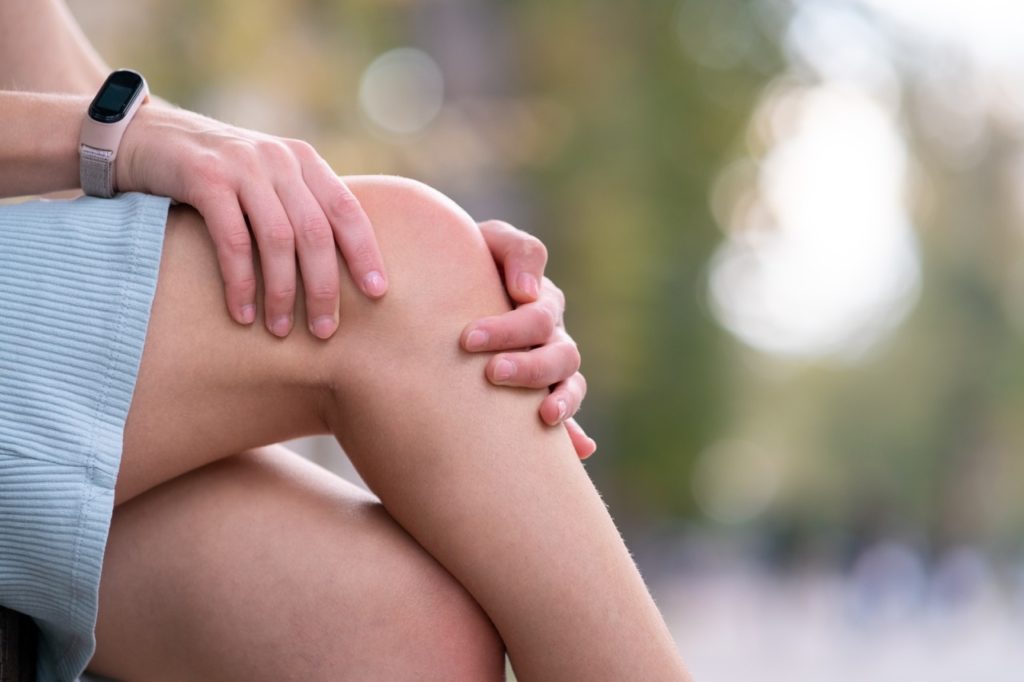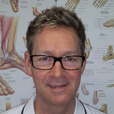Understanding knee pain
What causes chronic knee pain?
Chronic knee pain is amongst the most common complaints in the UK, affecting a wide variety of people at all stages of life. In children, the cause is often growth pains such as Osgood-Schlatter disease, which can last throughout adolescence and teenage years. This disease is caused by rapid growth that puts stress on the knee.
In adulthood, chronic knee pain is commonly caused by exercise and stress injuries, Patello-femoral Syndrome or Chondromalacia Patellae (also known as runner’s knee).
It is natural to experience more frequent injuries as time goes on, as stress fractures and strains occur over time due to impactful activities, including cartilage wear and tear, muscle imbalance, and abnormal foot biomechanics.
As a result, it is important to protect the knee with appropriate supports and correct positioning. Knee pain support and treatment should be an ongoing effort rather than simple pain relief to reduce the risk of worsening an injury.
There are various causes of knee pain, which can be due to a combination of factors. What causes knee pain is often the wear and tear that occurs with age and general usage. Softening of the cartilage beneath the kneecap (patella) results in small areas of breakdown and pain around the knee. Instead of gliding smoothly over the knee, the kneecap rubs against the thigh bone (femur) when the knee moves, leading to abnormal wear. These changes can range from mild to complete erosion of the cartilage, causing extreme pain.
Knee pain can make everyday activities painful and difficult. Activities such as standing and walking can become a daily challenge, making every day an unpleasant experience.
Knee pain can also affect athletic performance and overall quality of life.
Another very common cause of chronic knee pain is fallen arches in the feet. Knee pain occurs when the knee forms the link between the upper and lower leg. The knee is a hinge joint designed to flex and extend the lower leg, not to rotate it. When the foot rolls inwards, the lower leg is forced to rotate, inevitably leading to wear and tear of the knee joint, causing long-term damage and pain.
Of course, one-off injuries can also be what causes knee pain, but you are more likely to experience the following if you already suffer from long-term chronic knee pain:
- ACL Injury (ligament tear)
- Fractures
- Torn Muscles
- Patellar Tendinitis
How to reduce knee pain
Knee pain treatment for stress or long-time concerns is preventative rather than reactive. When considering how to reduce knee pain, general health, combined with the use of orthotic insoles, is an important combination for the success of any knee pain support plan.
Factors that can impact your knees include:
- Weight – maintaining a healthy weight can reduce the mass and impact on your knees and act as one of the best knee pain relief methods.
- Abnormal foot biomechanics can play a significant role in causing knee pain because it affects the legs, knees, and hips.
- Over-pronation can lead to Kinetic Chain abnormalities. This condition occurs when the ankles tend to roll inwards, which can cause abnormal stress further up the kinetic chain, including the knee joint, hips, pelvis, spine, and upper limb.
Roll of the kinetic chain
The kinetic chain is a classification system that refers to interrelated parts of the body (e.g., joints and muscles) and how they work together to perform movement. The upper-body kinetic chain starts at the spinal column and includes the scapulae, shoulders, upper arms, elbows, forearms, wrists, and fingers.
Excessive foot pronation (fallen arches) can lead to patients developing an asymmetrical body foundation and dysfunctional kinetic chain. As you follow the feet upwards, the effects that the feet have on the body work through the linked points that form the kinetic chain, starting with the legs and the knees.
The connection between foot and knee pain
This connection is often caused by a breakdown in the arch support, leading to Pronation. Within the feet, this may cause numerous problems, such as Plantar Fasciitis (Policeman’s Heel), Bunion Pain, Heel Pain, Arch Pain, etc.
This is where the Kinetic Chain link starts to be involved. As explained, the kinetic link with the entire body’s first major joint is the knee joint, which involves the feta (thigh bone), tibia (shin bone), and patella (very complex knee cap).
Knee pain treatment
Correct diagnosis is always very important. Seeing your GP is often advisable for examination and possible X-rays. Should significant Osteoarthritis be found, possible anti-inflammatories or analgesia medication may be prescribed, and orthopaedic referrals may be offered.
Podiatry may also be a treatment option to investigate the possible foot posture link with the knee via the Kinetic Chain. If the link is seen, possible correction of the abnormality is made via the use of orthotic insoles.
What are orthotic insoles?
Orthotic insoles, also known as foot orthotics or shoe inserts, are medical devices designed to support and align the foot. They can be used to treat kinetic chain problems higher up the body and a wide range of foot conditions, including back pain, arch pain, flat feet, knee and hip pain, and high arches.
These insoles come in various shapes and sizes to accommodate different foot shapes and types of footwear. They can be made from various materials, including foam, gel, or plastic, and can provide cushioning and support in specific foot areas.
At Waverley Clinic, we provide custom orthotics designed with state-of-the-art GaitScan technology. The scan provides a 3D image of the feet walking and standing to diagnose the cause of the problems and allow orthotic insole prescription design. This 3D scan of your foot shape ensures a perfect, comfortable fit and effectively addresses any specific issues related to your foot posture.
What are the best heel pain relief insoles for Knee pain?
The best shoe insoles for sore heels will vary depending on the underlying cause of the pain. It is always recommended to consult with a healthcare professional, such as a Podiatrist, to determine the most suitable type of insole for your specific needs. Some common types of insoles that may help with heel pain include:
- Orthotic insoles: These custom-made specialist insoles are specifically designed to reduce pressure, relieve knee pain, and address any underlying biomechanical issues contributing to heel pain, offering a tailored and effective solution for managing discomfort.
- Arch support insoles: these can provide additional cushioning and shock absorption support for individuals with high arches or flat feet/fallen arches, helping correct associated Kinetic Chain problems.
- Cushioning insoles: these are designed to provide extra padding and shock absorption, which can be beneficial for individuals with conditions such as knee pain.
What can I expect when being examined for orthotic insoles?
If you’re experiencing heel pain and are considering orthotic insoles, the podiatrist at Waverley Clinic will perform a comprehensive Biomechanical Assessment examination to determine the optimal treatment plan. This may include:
- Taking a medical history and discussing any previous foot issues or injuries.
- Examination of the lower limb, feet, and gait is done to look for signs of biomechanical abnormalities or other contributing factors to knee pain.
- Using GaitScan technology to analyse your foot posture and gait pattern provides valuable insights for creating custom insoles.
- Discuss any lifestyle factors or activities that may contribute to knee pain.
- We look at the patient’s lifestyle to ensure the orthotic insole material is suitable for their activity, e.g. flexible/high-impact material orthotics for runners.
- Looking at the patient’s shoe choice to ensure the orthotic insole chosen will fit into the patient’s shoes.
Based on the findings from this examination, our podiatrist will recommend the most suitable type of orthotic insole with a personalised treatment plan to manage your knee pain effectively.
GaitScan technology
As mentioned earlier, GaitScan technology is a state-of-the-art tool that we use here at Waverley Clinic to analyse foot posture and gait patterns. This advanced system utilises pressure plate sensors to create a 3D image of your feet while walking, providing valuable insights into how your feet function and any potential Kinetic chain issues.
By using GaitScan technology, our podiatrist can accurately assess any biomechanical abnormalities, determine the possible root Kinetic cause of your knee pain, and create custom-made orthotic insoles that absorb stress-inducing shock and address your specific needs. This advanced technology allows for a more precise and effective treatment approach, resulting in better outcomes for our patients and successful pain resolution.
What are the benefits of a biomechanical assessment?
A biomechanical assessment can provide numerous clinical benefits concerning knee pain and other conditions. This includes individuals of all ages and activity levels. Some potential benefits include:
- Injury prevention / Core strength / Fall prevention: by identifying any imbalances or weaknesses in the body, a biomechanical assessment can help prevent injuries from occurring.
- Improved performance: through targeted exercises and interventions, a biomechanical assessment can help individuals improve their movement patterns and optimise their performance in sports or daily activities.
- Pain relief: if an individual is experiencing pain or discomfort, a biomechanical assessment can identify the underlying cause, including pressure points that may be the source of chronic pain, and provide targeted treatments to alleviate it.
- Personalised treatment plan: a biomechanical assessment takes into account the individual’s unique body mechanics and movement patterns, allowing for a personalised treatment plan that addresses their specific needs. This can lead to more effective and efficient outcomes.
- Long-term benefits: by addressing any issues early on, a biomechanical assessment can have long-term benefits for an individual’s overall health and well-being.
A biomechanical assessment is a comprehensive evaluation of an individual’s body mechanics, movement patterns, and muscle function. It can provide numerous benefits, including injury prevention, improved performance, and personalised treatment plans.
Final thoughts: book a biomechanical assessment at Waverley Clinic today!
Whether you are suffering from knee pain at any age, an athlete looking to improve your performance due to foot pain or discomfort, or simply want to ensure your overall foot health, a biomechanical assessment at Waverley Clinic is the first step towards achieving these goals.
Our experienced team and advanced technology can provide a thorough analysis of your feet and lower limbs, leading to tailored treatment plans that address any underlying issues and improve your overall movement patterns.
So don’t hesitate to book an appointment today at Waverley Clinic by calling our 24/7 reception desk. 01252 716611.

